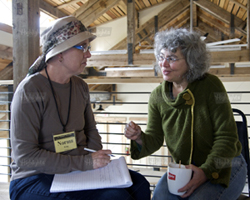
Norma King with Donna Jo Napoli (on right).
List three historical events that shake you somehow. Maybe they’re awful or full of grace or so unlikely they are hard to believe. It doesn’t matter. All that matters is that they shake you.
Now pick the one from those three that shakes you to the core.
Your job now is to figure out why. If the event is one you lived through, you have your answer as to why it matters to you.
If the event is not one you lived through, when and how did you learn about it? From a book? A movie? Perhaps a family story? What in the telling made it come alive for you?
What in the telling made you believe it? You didn’t live it – so why believe it?
That’s the key, I think – to all fiction. You have to make the reader trust you that this is going to be a true story, even though it’s fiction – even fantasy fiction. Does that sound like a contradiction? It’s not. We simply need to make a distinction between facts and truth. What I mean when I say that fiction must present a true story in order to matter to us is that particular facts about particular fictional individuals might be entirely made up – but the world of the story will be internally consistent (especially if the story is fantasy) and coherent with what we know about worlds (especially if the story is historical fiction). And, most of all, there will be a thread of truth that holds it all together. It’s the truth of it – the cruelty in an awful story, the glory in a story of grace – that makes a story resonate within us. That’s what keeps us reading past the first page.
Non-fiction historical books bombard us with facts. Speculation rarely enters. Motivation is often illusive – especially if we read about a controversial issue (like why the USA dropped bombs on Japan in WWII). We can feel lost, confused, and, as a result, uninterested. Basically, the problem is finding someone to identify with – someone whose eyes we can look through as we navigate historical events. Historical fiction, instead, gives us a body to crawl inside of and experience the event through, as though we are there. We are privy to all the hopes, fears, hates, desires of that character. The story grabs us and won’t let go precisely because we become that chosen character in the story.
Our job as writers is to grab. And I believe the best way to learn how to grab is to understand what grabs you. You need to face what you care about. And not just a cool, intellectual care. You must care desperately. Because if you don’t care about it desperately, you have almost no chance of making your reader care about it.







